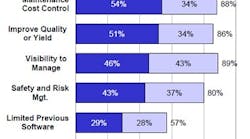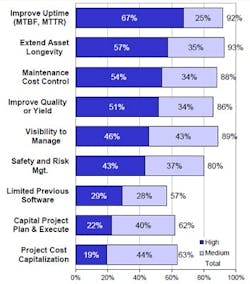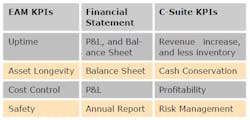The answer to a survey question goes beyond enterprise asset management (EAM) software and applies to the executive business case for nearly all of your projects. In a joint survey between Plant Services and ARC Advisory Group, respondents rated “project justification” as the top reason for a successful EAM software implementation. A good business case gains executive support, which leads to resource allocation that assures success. And your next justification can tie improvements to executive metrics.
With the improving economy but revenue growth still a challenge, C-suite executives — namely, the CEO and CFO — now look for cost improvements to improve profitability. Recently, their attention has moved from outsourcing toward improving internal manufacturing productivity. Of course, this attention includes maintenance and asset management. Many organizations are upgrading their EAM systems and modernizing business processes.
What leads to a successful project implementation? The research by Plant Services and ARC Advisory Group provides the answer. Most of the 134 participants are involved with multiple plants, and their responses represented input from a total of more than 15,000 facilities worldwide. This provides a substantial body of knowledge for insights on maintenance management and asset-management-software applications.
What drives software project success?
This year’s survey included a new question, “What affect did these factors have on EAM/CMMS implementation or improvements?” Those surveyed could choose one of these responses for each factor:
- big negative
- detriment
- neutral
- benefit
- high positive.
The chart contains a weighted average response for each factor (Figure 1). Overall, most of the responses were neutral to high positive. Hence, each factor has a net positive rating.
Figure 1. A good business case gets management’s interest and support.
For the question’s responses, technical support, IT support, selection process, project management, integrator, training, and budget were included, assuming these would have high rankings. Because the survey tool had room for additional factors, two more were casually added: business case and management support.
Surprisingly, the business case and management support were on top in the rankings. Perhaps I’ve read too many Dilbert cartoons and books by W. Edwards Deming, both of which tend to put management in a bad light. However, upon reflection, the reason for the high ranking becomes obvious. A good business case gets management’s interest and support. A key function of management involves the allocation of resources. The project gets the needed resources that ensure successful project implementation.
A good business case determines project success because a good business case drives management support, which provides allocation of needed resources, enabling successful project implementation.
What makes a business case for an EAM system?
Executives in the C-suite respond to their metrics just like the rest of us. The C-suite’s metrics are very public; quarterly reports contain the profit-and-loss (P&L) statement and balance sheet, which financial analysts carefully scrutinized. A good business case connects the benefits of an EAM system with the financial metrics in those financial reports.
The survey question, “Please rate the drivers for having an EAM application,” offered respondents four choices for each of the business drivers:
- high
- medium
- low
- not a factor.
Figure 2. Improved uptime topped the list of survey participants’ EAM application drivers.
The chart contains the high and medium responses to visually emphasize the key drivers (Figure 2). The benefits of an EAM system read like “getting back to basics” with the five goals of uptime, asset longevity, cost control, quality, and safety. They directly affect C-suite metrics in the P&L statement, balance sheet, and annual report with regard to revenue, cash conservation, profitability, and risk management (Table 1).
Table 1. Consider the key performance indicators that impact the P&L statement, the balance sheet, and risk mitigation.
Impact on P&L statement
Improved uptime for production scheduling: Good maintenance reduces the chance of an equipment failure, which has particular importance while in production. First, the unscheduled downtime causes losses in direct labor and, often, work-in-process (WIP) materials. Obviously, these losses have a direct negative impact on the P&L statement.
Second, with today’s tight scheduling with minimal inventory, an interruption becomes missed shipment dates, customer satisfaction issues, and reduced revenue. The lower revenue also negatively impacts P&L.
Cost control for maintenance labor and materials: First, with a run-to-failure maintenance strategy, the demise of an inexpensive component cascades into other, more expensive system components — just as the loss of $15 of engine oil will cause your car’s engine to seize for a $5,000+ repair. Without maintenance, repair costs escalate dramatically.
Second, maintenance managers have significant budgets with labor, contractors, materials, inventory, schedules, and competing priorities. They need a modern EAM system to execute a preventive maintenance strategy, while also controlling costs that are part of P&L.
Third, upgrading to a modern EAM system allows rationalizing applications and instances and focusing on one EAM system. This eliminates significant IT costs.
Impact on balance sheet
Extend asset longevity: First, maintenance extends the useful life of assets, delaying the need for costly capital projects for replacement or refurbishment. Proper maintenance reduces capital expenditures and conserves cash. Second, the increased uptime provides additional production capacity and avoids procurement of more equipment as the business grows. By delaying capital expenditures, significant cash is conserved. With more cash, financial metrics improve and the stock price goes up.
Improved uptime for production scheduling: This benefit also affects the balance sheet. Materials are queued between operations to buffer interruptions, including equipment failures. Better maintenance and higher equipment uptime reduces uncertainty and allows a reduction of inventory. Again, the added cash improves stockholder value.
Impact on risk mitigation
Safety and risk management: Catastrophic equipment failure can put nearby people in danger. Also, failure of a major system can cascade into other systems, representing a significant business risk. Governance, including Sarbanes-Oxley, necessitates good maintenance.
Modern EAM system helps the C-suite
Businesses have many complex and critical pieces of equipment, and maintenance often involves thousands of assets. How does a maintenance manager know what is the most important item to work on next? EAM systems provide visibility for priorities and help managers to execute maintenance, including labor, inventory, service contracts, and reports. Businesses require EAM to successfully execute maintenance, which improves their P&L statements and balance sheets. EAM functional groupings include asset information management, work order management, MRO materials management, labor management, service contract management, financial management, and reporting and analytics. Particularly for asset-intensive industries, a modern EAM system helps the CFO to sleep well.
Recommendations
Well-executed maintenance makes nearly everyone else look good. We need to communicate this in terms that allow others to see the connection. Otherwise, executives will want to “optimize” (translation: reduce) maintenance costs with not so optimal results.
First, read the chairman’s letter, which typically appears at the beginning of your company’s annual report. This provides the key concerns and outlines the major business strategy. Finding a connection to your project provides a good start for getting C-suite attention.
Second, connect the specific project benefits of your project with profitability in the P&L statement and with assets in the balance sheet. High asset performance enables excellent financial performance. Good maintenance management improves many of the financial measures of a business and the stock price. Maintenance departments need a modern EAM system to improve financial metrics, such as quick ratio and return on assets (ROA) that affect shareholder value.




